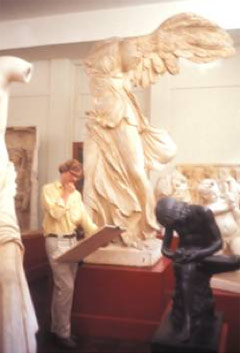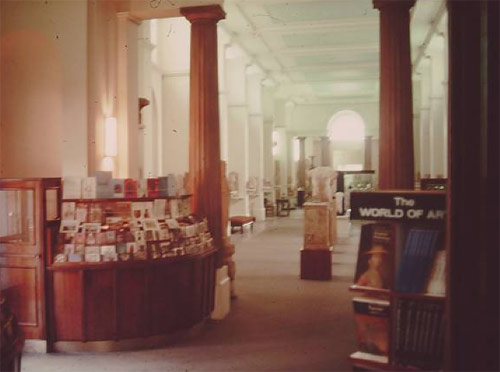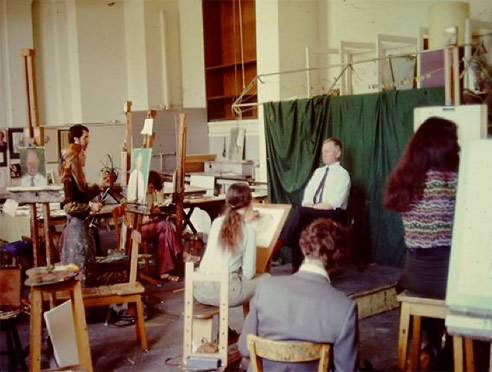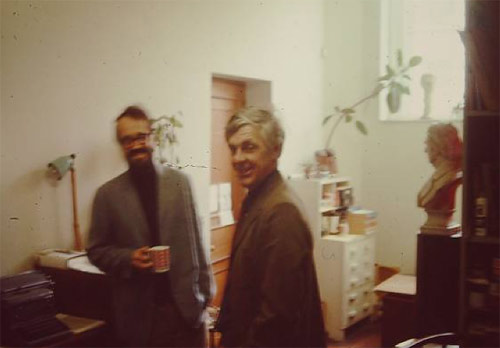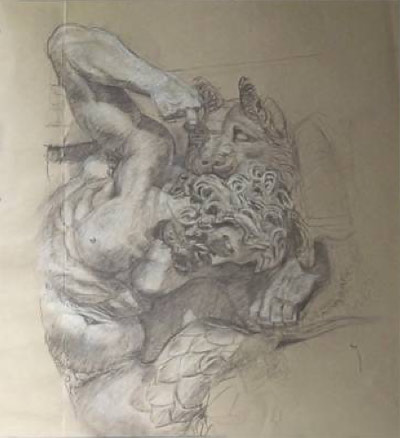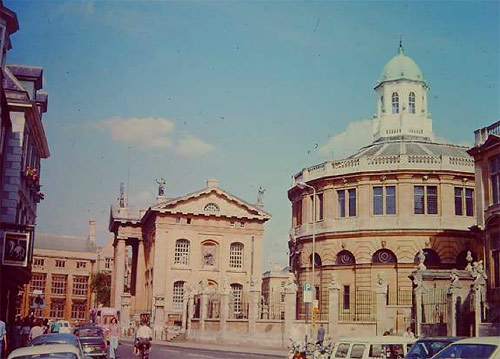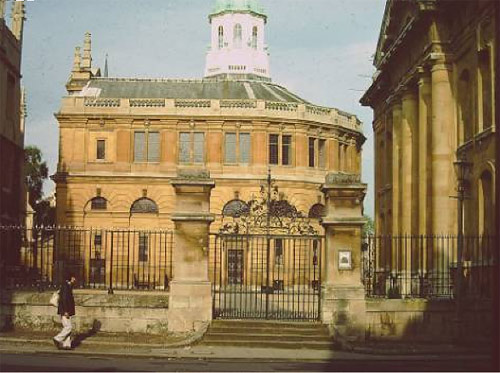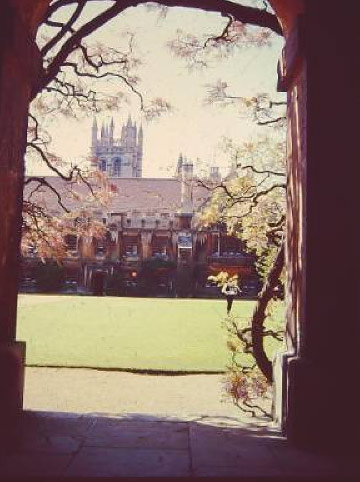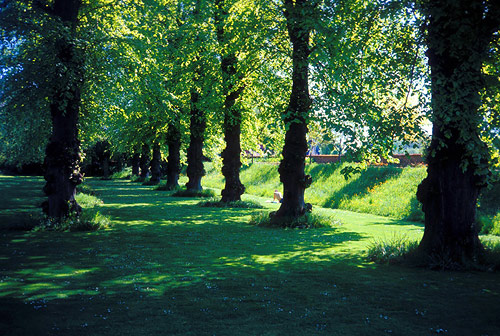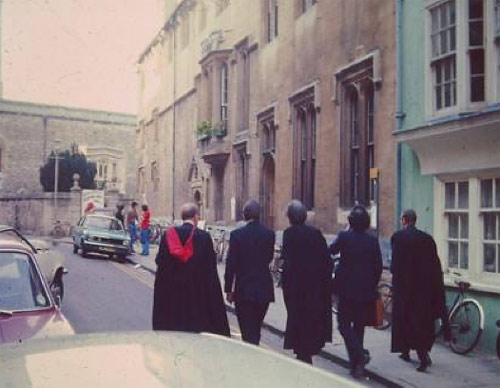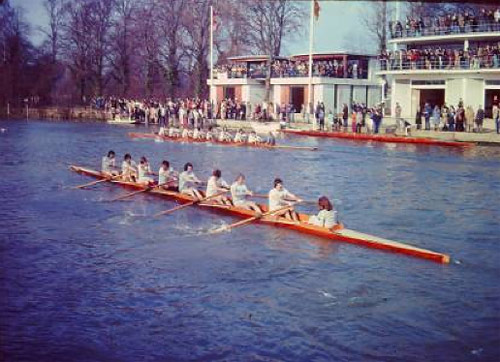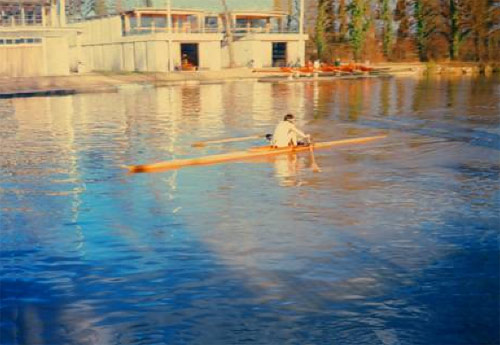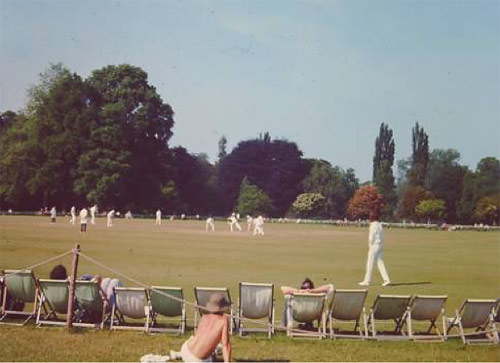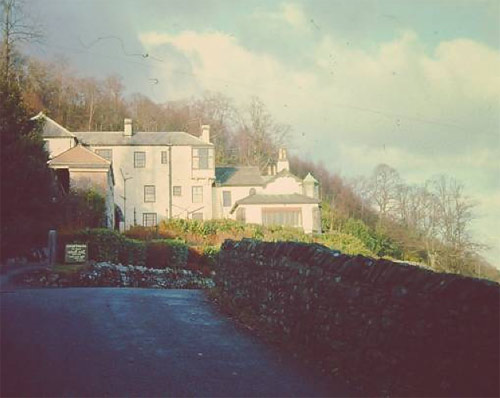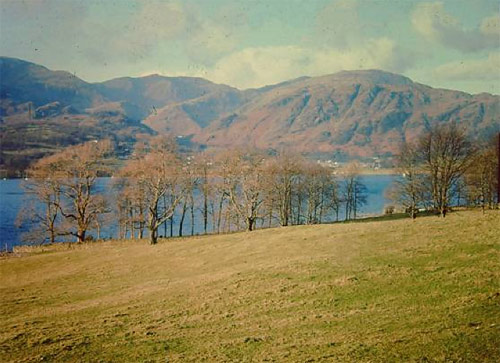
ESSAY: Studying Art at the Ruskin School of Drawing and Fine Art By Christopher S. Gerlach
I made the decision to become a professional artist in 1974 while on a year's program studying abroad at Oxford University. While there I discovered that a Art School founded by John Ruskin in the late 1800s dedicated to teaching the fundamentals and the academic discipline of art was still very much active and I was able to arrange to attend classes there and do some study with the Drawing Masters. It was a remarkable experience and after returning to the United States to obtain a Masters Degree in Art from San Diego State University, I returned to the Ruskin School, which had moved from its original location in Ashmoleon Museum to new quarters on High Street next to the Examination Schools for the University. I graduated from the Ruskin School in 1979 and returned to the United States to begin my own career as an artist pursing my own path as a realist painter, working in a style that now is called Painter Realism but which had its foundation and roots in the Impressionist School of Monet and the painterly realism of John Singer Sargent, Winslow Homer, Whistler and many other fine painters of the era between 1880 and 1930. By the time I was starting to study painting on my own in the early 1960s, the art world had become almost completely dominated by Abstract and non realistic art. There were lingering vestiges of what had formerly been the entire focus of Fine Art on interpreting the world for world cultures of all kinds in a realistic or stylized way, but always with the fundamental basis in reality and with recognizable imagery. This change had been brought on by a number of factors, including terrible world events including two world wars that decimated the international culture of Europe and beyond twice in 50 years, and related social trauma that have still major effects on life and culture to this day. Because of this radical shift partly sponsored by targeted and clever marketing by some key art dealers and the elite of the related disciplines of Academic art shifting from its traditions and the past, the art world that I entered in 1979 was a wasteland for a realist artist. Since then there has been a revival to a degree of realistic painting, in both pseudo impressionistic style and the other extreme of photo realism in which the artist has become a human camera recording to a extreme degree every thing that the eye sees. In this evolution or some of us think, this devolution, the traditions and even the very meaning of Art has become confused and to some degree lost. It has been my determination to preserve and to continue to develop and support the long historically meaningful nature of Art, Fine Art, in my own work and to study modern Visual Culture in all of its various and new directions and dimensions. I have always felt that an artist, a Fine Artist, should be willing to stay open to new ideas as well as to support traditional ones and to find a personal balance and expression that is meaningful to both themselves and to their patrons, collectors, and those who can and do appreciate their art. It has been said recently in the media that some say now that Anything can be Art. This is just about as far from the truth as any statement can be, I feel and think. If anything can be art, then nothing is really art anymore. If Everything can be anything, then there is no meaning at all in distinctions and value. Art is a word that describes creative work that expresses meaning to a culture and within its own time. It is an object that is not only a physical thing, painting, statue, sculpture, drawing, etching, stained glass window, vase, pottery, carving or other form, it is an object with meaning and content. That content IS the purpose of the object, and the object has meaning based on that content, on what the viewer or the reader or the audience can share with the creator and what the work of art “says” or expresses. One of the problems with modern abstract individualist creations is that they are opaque, almost impossible to understand …..to really KNOW what the artist was trying to say or mean. So it become meaningless and as such is just then, and only an object. It has no meaning other than just what it IS. I sensed this crisis of content long ago, when I was still just a beginning art student. I spent 10 years myself training in the craft and the learning of my own art, before I even thought to exhibit professionally, and to call my self an Artist. I am still learning and expanding, studying new genres and mediums and active in supporting research and working in them as well as in my own painting craft and aft. The trends have been more and more extreme in the outer art world. New attempts have been made to carve out territory for groups and individuals, including performance art, which can be just about anything including some extreme and bizarre events, installations of large size and vague intent, and through it all, both among the active creators and the supporting media, academic fields and schools, university art departments, art galleries, art dealers, and now internet online website and associations to promote artists and art work, few speak out about the chaos and loss of meaning that has spread far and wide. It is in this vacuum, and this void that Art, Fine Art continues to survive, but it is handicapped and at risk in some ways. Museums now exhibit just about anything, and the curators and the donors and supporters show no willingness to try to judge or determine value beyond what they are told IS art by some of the same dealers, scholars, “experts” who set value and price…and set the standards of what is art and what is not. It is not surprising that young activists now are attacking famous paintings in museums defacing them, and then saying that their own defacing is itself a work of art. The problem is that so much of what is Called ART is not really art at all, but it is displayed and valued, bought and sold as such and so has corrupted the entire idea of what Art is. This is not to say that no abstract painting can have value or be considered fine art, some are quite interesting and complex and beautiful in some ways. However and this is the bottom line and the fundamental fact that any rational person who knows art from the past and from a wide variety of cultures can only come to, Fine Art, true highest art, MUST have Meaning beyond its form, colour, shape or its Object nature. There is no way for the word ART to mean anything that anyone wants to make. Art has always in the past and must now in the present and future mean something that has more than just superficial form and is more than just a simplistic rendering of a scene or a face or a view. What was clear in the past and up until about 1930 was accepted and understood to be art was work that showed not only its subject but the skill, style and personal view of the artist. That personal touch, combi8ned with a recognizable subject rendered the Object, the Art work, more than just a thing or a picture, as we are speaking mostly here about visual art ….it became a synthesis of both the artist’s choice of subject and execution, it also had meaning for the viewer who recognized it and could have their own response to it, and in the case of a collector wanted to own it so that they could enjoy it in their own lives. The limitations of abstract or totally ego based created objects is that they are just that, there is little chance for the viewer to have any kind of deep personal connection to the artist or the artist’s effort or view because there just isn’t any way that the viewer can know for sure WHAT the artist meant to do. Shared understanding and empathy is the basis of fine art, just as it is in classical music, or all of the other traditional mediums and media…they all require life experience and sophistication on the part of the viewer, the listener, the reader beyond just an immediate and limited response. So we are now in the Void, confronted by the inevitable result of all of this nihilism, generations have been told that Art is whatever sells, and whatever the dealers and the art experts say it is. There is little way for the casually educated young artist or aspiring art student to form a reasoned and rational response, and so we see very irrational and unreasonable actions and responses occurring, and I expect it will get worse before it gets better. People find it frightening to stand up and oppose and to question what is widely accepted by the establishment. But it is necessary if true art is to survive for those of us who see this crisis and understand its roots and the dangers to Fine Art and appreciate of it to speak out.
The Ruskin School was founded by John Ruskin in 1871 to teach a solid and careful approach to learning to see and to understand what the artist was seeing by teaching careful draughtsmanship and rendering of what was seen. This was done by careful observation and execution in both drawing and later painting and the student was given solid teaching of techniques of seeing, measuring what one saw and transferring it to paper or canvas. The School had continued to teach this approach in an increasingly chaotic art world, and it had survived up until I found it in 1974 while I was studying at Oxford University as a graduate student, at that time I planned a career in History as a researcher and teacher and author. I had started to paint on my own with the encouragement of both of my parents who were both accomplished artists themselves and found a lot that I enjoyed studying art and artists of the past. I was able to study at the Ruskin School in the Cast Gallery, using pencil and a drawing bench, working for 8 hours a day, and also to observe the advanced students working in the main painting gallery at the Ashmoleon doing life work and painting from models including some projects that the University arranged where the students painted some of the College staff. Being at Oxford was itself an fascinating experience, the beauty of the colleges and their gardens, the historic buildings of the University, the lovely countryside, and the overall history and feel of it all was enthralling and very exciting to me as both an aspiring artist and a student of literature and culture especially the culture of Victorian and Edwardian Great Britain. The School itself taught rigorous discipline and the Drawing and Painting Master were dedicated and serious examples of their craft. I recall several very well, including Johanthan Newberry and Philip Gibbs. They were practicing and active artists themselves but they also enforced and supported a reasoned and rational approach to the work of art, while at the same time training and teaching the student to not only look but to SEE what they were looking at. The purpose of studying and drawing from antique casts had its roots in the School’s past: Originally the first Art School at the University had been run accodring to the Kensington Method of teaching rigorous and disciplined artisanship in art, studying and drawing from plaster casts of antique sculptures using a very careful and painstaking attention to exact detail and the study of carefully selected masters in the field. Students were not allowed to use any medium other than pencil on paper until an advances stage of their study and no use of colour until then either. John Ruskin felt that this method limited creativity and he designed a course of study that focused on a set of casts, sketches and paintings that he had chosen to teach various principles to the students, who still worked from these motifs following his designed course of study.
The Ruskin School that I found had combined both of these approaches and included elements of both. The Cast Gallery of the Museum was a testing ground of patience and discipline, the Drawing Master was firm about correct rendering and the standard was very high. I learned the foundation of realistic art was what WAS real, what WAS visible and though any artist would go beyond and past that, if one cannot render what is there, then there is no foundation to start from. It is the fundamental understanding of perspective, form, dimension, tone, shape, balance and colour and light that is the basis of any visual art whatever the subject or the medium. If the subject of study is simple with clear information to deal with, as a white plaster cast of a sculpture is, then the work is made more clear. I did not say easy for a student must wrestle with not only the rendering but getting the human shape, and figure correct, many pitfalls of easy looking, and casual sight lie in the path of a serious art student, and must be overcome. I was fortunate to find this precious opportunity that changed and may have itself vanished, for the School moved to a new location and new theories and influences have come to play. I have no sense now of what the School teaches, though it is still in operation, and has I hear widened its focus to include some new aspects of art. I just wanted to share here some of the fundamental ideas and elements that were essential to my own formation as a professional artist and which relate to my concerns about the nature of Art in modern world and its future. I want to close with just a few picture and memories about Oxford, and the University. It is a remarkable, incredibly beautiful place, filled with many layers of history and deep with culture and knowledge, truly a resource beyond compare or reckoning. Any culture is made of its own direction but also its heritage and England and Great Britain was deeply affected by the classical world, Rome, Greece and beyond and when the English culture began to flourish it drew on this past and these influences and they are there to see in Oxford as it has come to us today. Many of the main University Buildings are neo classical and beautiful in themselves as well as historic. They comprise the fabric of Oxford, an intricate web of colleges and little worlds each with its own deep traditions, inhabitants, both transient and long standing. The setting of them all with the college gardens and the surrounding countryside which is watered by both the Thames where the College boathouses are and the Cherwell River which is the beautiful setting for punts, and picnics in the spring – all of this creates a very special world. It was a world that excited me as an artist and I loved what I was able to find and paint there both then and since. The daily life of the students and the town was filled with activity that was a lively contract to the studies that filled my days but I found it very exciting visually and recorded much of it on film to work from in my studio for years to come.
I especially enjoyed the visual setting of the river activities and rowing, the beauty of the shells and the races and the traditional punts which were long used by river boatmen and had survived as part of the university culture intact with some wonderful memories of picnics and outings that happen every spring. Environment and Setting As a landscape artist I was always interested in the land and the country side and the setting of the English culture, both rural and urban. I was also interested to see the county house and studio of John Ruskin which he loved and maintained at Lake Coniston, in the Lake District. He was all his life seeking beauty and the meaning of beauty and he found a most beautiful place to live and work. I felt it was very important to my understanding of him both as an art critic and analyist and as the founder of the Ruskin School and a figure who shaped its transition to see what he chose as his own environment for an realist artist is much affected by their location and the feeling that they may have that arises from their environment. I traveled to Lake Coniston in the winter of 1974 and stayed at Low Bank Farm, which had been the lng time home of Arthur Ransome, the authour of the fames Swallows and Amazons childrens’ stories, just down the road from John Ruskin’s home Brantwood. It was a remarkable journey and I will in closing here some pictures of that place.
To Be Continued: One cannot say truly what path one’s life takes is doe to any one or any one set of decisions. I am glad I chose in the spring of 1975 to follow the path of an artist but it was to be far harder and longer than I ever expected. Now at the age of 60 I can look back on a lot of it as being remarkable and a gift of Fate, and I don’t have any regrets. I am glad to have some time ahead, and look forward to more exploration and growth both as an artist and a person. Here in closing is a picture of the me that I was then, spring of 1975. A lot lay ahead. Thanks for the chance to share some of this with you.
If you visit the Oxford Gallery here on my website you may see some of the paintings I have done over the years from some of the scenes described or shown here. Chris Gerlach History Summary of the Ruskin School of Drawing and Fine Art Ruskin School of Drawing and Fine Art Afterword I have continued to develop and expand my own artistic vision and interests and 12 years ago began to study digital art and virtual worlds and the creation of imagery that is three dimensional using computers and computer driven software. I have progressed in this study and research studying among other things, animation with a special focus on Japanese Anime, and also game design and development. I am the Administrator and founder of a large international working group of many related fields and aspects of Virtual World making, and continue in this research with the intent to develop new and innovative methods of creating “living” paintings that utilize the latest in digital technology, art works that I have come to call “Lumieres” and in 1998 I secured an International Patent in a process to create these dynamic scenes as a future form of art, though I am still engaged in the research and development of both the technique and also the theory and the ethical and social aspects for I do not intend to create yet another chaotic and unfiltered and unbalanced use of technology with no concern for impact or use. Stay tuned for future developments.
This work can be found here: Director, Creative Content Development at Lumiere 3D 3D World and Game Developers Group Linkedin 3D World and Game Development Research Blog Other Sources: Ruskin School of Drawing and Fine Art About the Author and Artist Christopher currently lives and works in Southwestern Colorado, in the town of Pagosa Springs
but is planning to return to live in Santa Barbara, where he grew up and which has always remained the home he has been away from. He was one of the first modern
artists to revive realism in paintings, and continues to work in this genre combining both plein air and studio work in his own unique blend of painterly style and
bright palette. He writes, paints and works to aid Ecology and other interests. He is also the Publisher of a small press dedicated to creating beautiful and insightful
works on social health and in aid of environmental causes.
He loves life, in all it’s surprising forms, and believes that we can, each of us, make a difference.
Current Gallery Representation and Vitae Commissions and Special Projects Welcome
|
